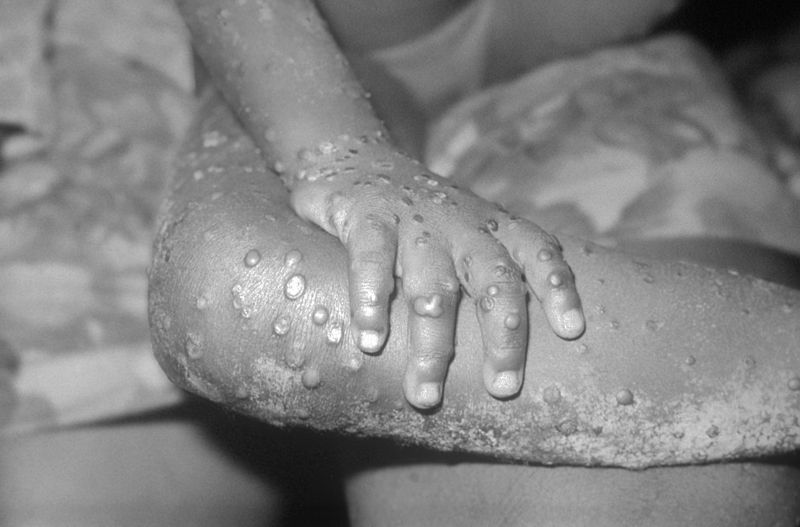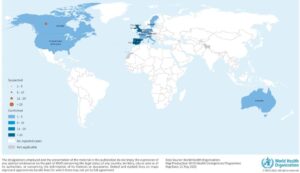What is monkeypox? Causes, Symptoms… 21st May 2022 – Tags: Fever, monkeypox, Monkeypox Symptoms, Rash, Virus
Monkeypox virus belongs to the genus Orthopoxvirus withinside the own circle of relatives Poxviridae. The genus Orthopoxvirus also includes smallpox virus (which causes smallpox), vaccinia virus (used in the smallpox vaccine) and bovine pox virus.
Monkeypox is a rare disease caused by infection with the monkeypox virus.
But while the transmissions have caused concern among government officials and infectious disease experts, and the Covid-wary world is on alert for any new outbreaks, there are several reasons why monkeypox is not being treated with the same degree of concern as coronavirus.
Here is what you want to recognise about monkeypox and the dangers it poses.
What is monkeypox?
Monkeypox is a pandemic endemic to elements of important and western Africa. It is a milder version of smallpox.
It was discovered in 1958 after outbreaks occurred in monkeys bred for research, according to the Centers for Disease Control and Prevention.
The first human case of monkeypox was recorded in 1970 in the Democratic Republic of Congo (DRC), during a period of intensified efforts to eliminate smallpox. Since then, monkeypox has been reported in people in several other countries in Central and West Africa: Cameroon, Central African Republic, Côte d’Ivoire, Democratic Republic of Congo, Gabon, Liberia, Nigeria, Republic of Congo and Sierra Leone. The majority of infections occur in the Democratic Republic of Congo.
Human cases of monkeypox have occurred outside Africa, linked to international travel or imported animals, including cases in the United States, as well as Israel, Singapore and the United Kingdom.
The natural reservoir of monkeypox remains unknown. However, African rodents and non-human primates (such as monkeys) can harbour the virus and infect people.
Symptoms of monkeypox
Symptoms and signs of monkeypox include :
It produces symptoms similar to those of smallpox, but milder. The time between infection and onset of symptoms, known as the incubation period, can vary from five to 21 days. The disease usually disappears in two to four weeks. Severe cases are more common in people with underlying immune deficiencies and in young children. In recent years, the case fatality rate – a reliable source of monkeypox – has been around 3-6%.
Monkeypox causes a rash that begins as flat red marks that become raised and filled with pus. Infected people also have a fever and aches and pains.
Symptoms usually appear after six to thirteen days, but can take up to three weeks after exposure. They can last from two to four weeks, with severe cases being more common in children, according to the World Health Organization.
The infection usually clears on its own and lasts between 14 and 21 days.
Background of the disease
Since 2018, 7 instances of monkeypox had been said withinside the UK (in 2021, 2019 and 2018), specially with a records of journey to endemic countries. However, that is the primary time chains of transmission had been said in Europe with out recognised epidemiological hyperlinks to West and Central Africa. These also are the primary instances said international amongst MSM. Monkeypox virus is taken into consideration to have mild transmissibility in humans. In this case, transmission among sexual partners, because of intimate touch at some point of sex with infectious pores and skin lesions, seems to be the in all likelihood mode of transmission in MSM. Given the unusually high frequency of human-to-human transmission observed in this event, and the likely community transmission without a history of travel to endemic areas, the probability of further spread of the virus through close contact, e.g. during sexual activity, is considered high. The chance of transmission among people with out near touch is taken into consideration low.
The extent of community transmission is currently unknown. However, targeted testing of individuals with such clinical manifestations is starting to be performed in the relevant EU/EEA countries.
The clinical manifestation of monkeypox is generally mild. The West African clade, which has so far been detected in reported cases in Europe, has been observed with a case fatality rate of 3.6% in studies conducted in African countries. Mortality is highest in children and young adults, and immunocompromised people are particularly at risk of severe illness. Most humans get better inside some weeks.
Virus update
A monkeypox case was identified in an individual with recent travel history to Nigeria.
On 14 May, 2 in addition instances, with out a recognised hyperlinks to the case introduced on 7 May, had been said in people from the identical household.
On 16 May, 4 additional monkeypox cases were reported in England. These cases have no known connections with the cases reported on 7 and 14 May. Contact tracing and investigations are ongoing to identify where and how the cases reported on 14 and 16 May acquired their infection.
References
There is a problem with website.
We got the information and are already on it. Please check back later.




